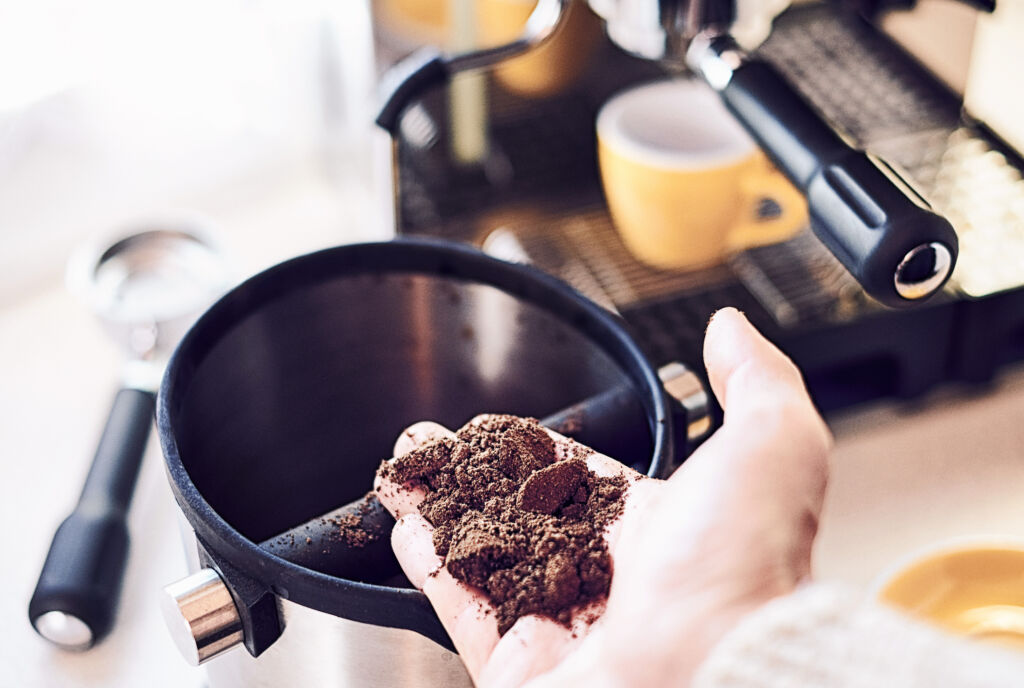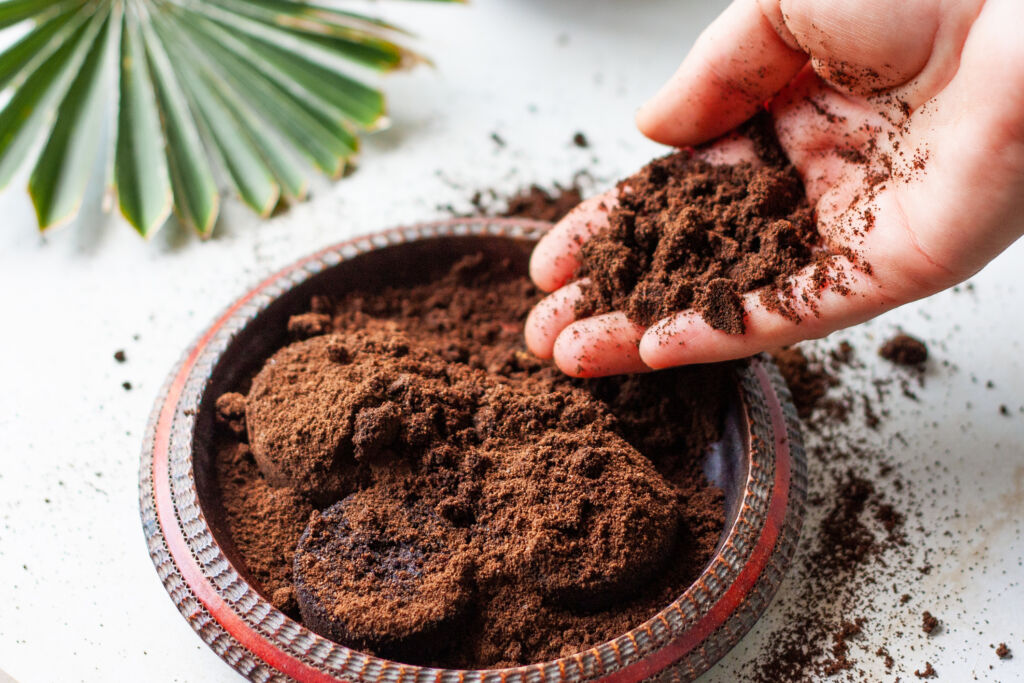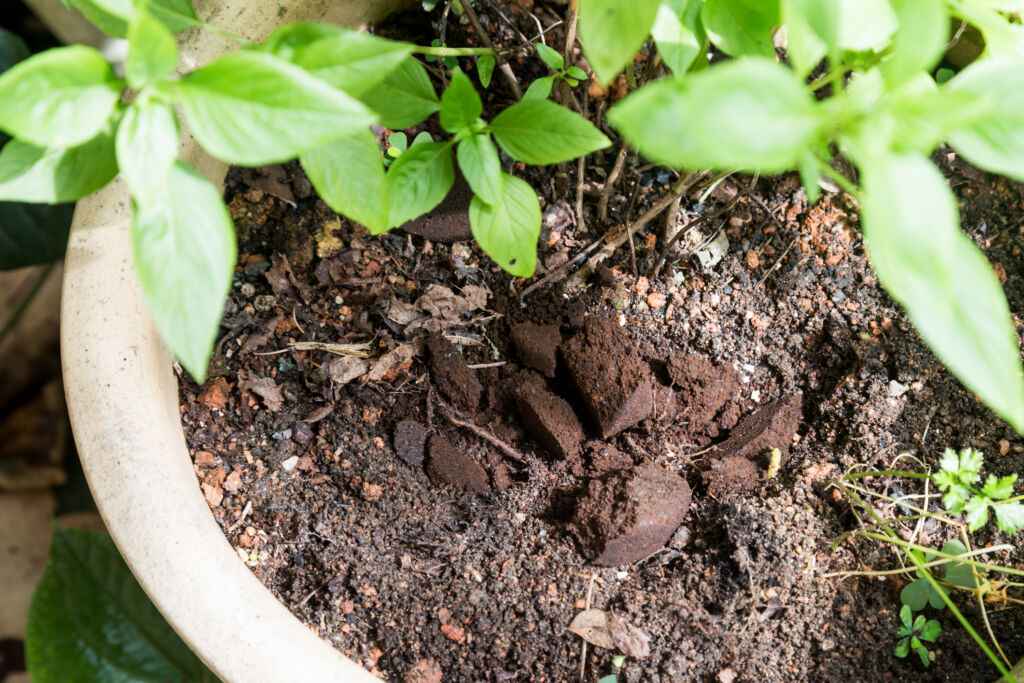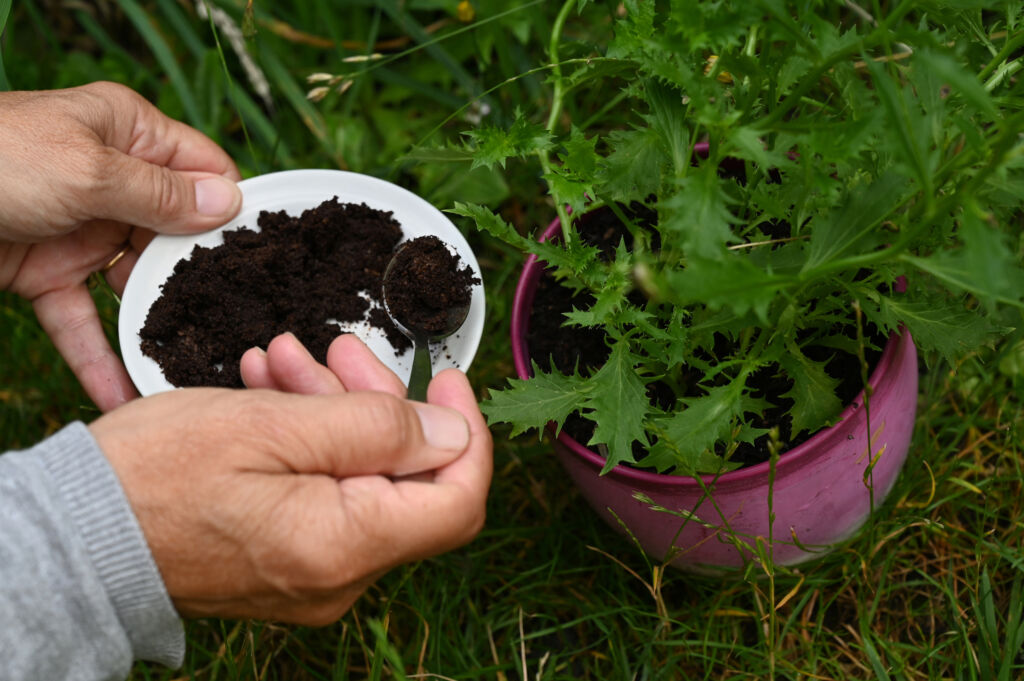HousePlantJoy is supported by our audience. When you purchase through one of our links, we may earn a small affiliate commission. As an Amazon Associate I earn from qualifying purchases. Your cost is not affected.
==================
You Can Use Coffee Grounds For Houseplants
For gardening, it makes sense to use coffee grounds for houseplants. If you’re a regular coffee drinker, you might as well take advantage of your leftovers. Putting them in the trash seems like a waste when they can still serve. They can help make gardening inexpensive and impressive somehow. Besides, these organic matters are rich in nutrients. Hence, it’s clever of people to recycle these dregs. Folks even try the other things used for coffee grounds processing in gardening.
If you’re looking to provide some practical boost to your plants, then use these. Spray or spread these sediments in your greenery after you’ve had your brew. Even as fresh or unbrewed grounds that are more acidic, they are still ready to sprinkle. Doing so may also give your vegetation caffeine to use. In this post, we’ll explain further the points mentioned and why a coffee fan would want to do these things. So you may want to stick around and grab a cup of coffee for this one.
Why Use Coffee Grounds For Houseplants
The sediments themselves and other things used for coffee grounds processing have benefits. The java residue is rich in nitrogen and has traces of phosphorus and potassium per volume. These help plants form well, get energy, and produce fruits, vegetables, or flowers. Aside from the essential plant macronutrients, it also contains some micronutrients. Examples are calcium, copper, magnesium, iron, manganese, and zinc. These nutrients improve the plants’ physical barriers against pathogens and elongate their stems. Coffee residue also makes planting or landscaping comfortable since it absorbs unwanted odors. So, given these advantages, it makes sense to use coffee grounds indoors and outside.
Their presence in the soil makes a difference too. Sprinkling them on the ground helps aerobic bacteria and worms thrive in the soil. Beneficial bacteria decompose organic matter and use java dregs to get oxygen. Worms promote better soil structure and drainage and feed on plant debris. Also, coffee grounds supply them with nitrogen and other elements to keep them going. The java sediments are also natural insect deterrents and killers. They contain chemicals like caffeine and diterpene, removing mosquitoes, flies, and beetles. They put a blockade to stop snails and slugs from reaching plants. Hence, many don’t throw away their brew residue and use them for gardening purposes. Many plant containers indoors sometimes have them.
How To Use Coffee Grounds For Houseplants
In a nutshell, people put traces of coffee sediments in the ground to introduce nutrients to the soil. Gardeners and farmers scatter or surround plants with them. Often, people combine compost and other materials with coffee residue. Others mix coffee residue with water and spray the solution on their greenery. Some folks use the filter used for coffee grounds handling for gardening too. Using java sediments and filter paper helps increase one’s green compost. Together with brown fertilizer, they make excellent plant food. Thus coffee drinkers save what they use for brewing java for gardening. It applies even if the plants are inside.
Raw coffee grounds make the soil acidic. But that’s not the case when using sediments from brewed coffee. Making java removes the acidity since coffee bean grounds are water-soluble. Using them on the earth keeps the soil pH neutral. It makes the earth ideal for planting crops. Plus, having high nitrogen content makes them good slow-release fertilizers. Still, direct application to the soil to serve as mulch is also an option. But it’s best to have the sediments mixed with other mulching ingredients. So we can say that coffee grounds help protect and enrich the soil. We can use them in large garden spaces and even individual pots.
When To Use Coffee Grounds For Houseplants
There’s no specific time to take advantage of the items used for coffee ground filtering. But, when available, some methods help to repurpose and get the most out of them. For instance, once dried after brewing, they are ready to recycle as mulch or fertilizer. Yet you still need to avoid keeping the earth too moist and feeding too much plant food. Excessive amounts of both suffocate plants. Hence, you still need to time when to use the java sediments.
Mix small amounts of coffee sediments with wood chips or other mulching materials. It’s already enough to help with weed suppression, water retention, and soil fertility. A cup of coffee grounds may also suffice to take about 10 to 20 percent of your compost volume. Applying once weekly keeps you from overdoing it. But, as mulch or plant food, the layer of coffee residue on the earth must not be too thick. Excessive amounts inhibit plant growth and development. Caffeine in java residue slows and may stop shoot growth and root formation. It’s because coffee is allelopathic or influences seed germination and general plant growth. So apply, observe, and make adjustments as needed.
What Plants Like Coffee Sediments
A lot of java fans use coffee grounds for houseplants. But this doesn’t mean that all plants in an indoor or outdoor garden love it. Some herbs, shrubs, or trees like them more than others. So, before mixing brew residue with water for spraying or with compost for plant food, check first. It’s crucial to use coffee grounds only for plants that need them. Many times, these are the ones requiring a lot of nitrogen. Classifications like succulents and angiosperms could enjoy coffee residue. So consider these before trying filters and others used for coffee grounds processing.
Plants like the Christmas Cactus, Devil’s Ivy, and Philodendron can use java residue. Watering with black coffee can help these plants thrive longer. Adding java-enriched water to the potting mix promotes better leaves and flowers too. Such makes plants like the African Violet and Jade Plant can have thicker and stronger stems. Yet you always need to use reasonable amounts of coffee sediments only. Large quantities can prove to be fatal to a lot of plants. So there must only be about 1 part of coffee ground per 3 parts of mineral or organic soil.
Plants That Don’t Like Java Residue
Sometimes it makes sense not to use coffee grounds for houseplants. Not everything is fine despite processed coffee beans turning neutral somehow when diluted. Traces of coffee residue may stay acidic. Using them can be fatal to plants that demand neutral or alkaline soil to thrive. Begonia, wood sorrel, lavender, and asparagus fern may not do well with coffee residue. Herbs like oregano and thyme may also find them too acidic. Hence, before putting coffee-enriched things near or on plants, research. It’s to make sure that you won’t end up killing your garden companions by accident.
Using too much coffee residue on plants will cause a nitrogen surplus. When plants have more than enough of it, they become susceptible to diseases. Thus, when there are rich fertilizers present, there’s no need to give brew leftovers. Because of it, you shouldn’t give houseplants that thrive in nitrogen-deficient soil. It’s not advisable to supply coffee grounds to most carnivorous plants. Examples are the indoor Venus flytraps and pitcher plants. These plants don’t even need fertilizer and may demand insects for nutrients. In this way, it’s sensible to know the soil requirements of plants. That would be before you try to expose them to the coffee residue.
Tips When Using Java Sediments
Be careful when you use coffee grounds for houseplants. Using them without practicing caution may be risky. Coffee grounds are inexpensive, but using the right kinds and amounts is crucial. For instance, many say it’s better to use diluted than fresh coffee grounds. Fresh ones are more acidic and deliver more caffeine. It’s when compared to cooked coffee grounds. Be mindful of this despite caring for acid-loving plants like azaleas and blueberries. Making it no more than a fifth of your compost is good. Keep the ground level with the java brew residue and observe your plants’ reaction days after.
As much as possible, use coffee residue only when you have mature plants. Seedlings might not withstand the rich nutrients the coffee grounds can provide. Consider it even if your greenery has acid-loving varieties. Being careless may cause germination problems. Use the brew residue to draw worms and to secure plants from certain pests. Form barriers around the plants in your pots to keep gastropods and some insects away. But don’t create clumps that can saturate the soil with nutrients. So do it right and be strategic when using coffee grounds, and you will get their benefits.
In Closing
People favor and use coffee grounds for houseplants since they are cheap and healthy. Folks put the residue of brewing java on plants due to their high nitrogen content. We can say that they provide a lot of energy for our garden companions. But they are acidic, and acid-loving plants enjoy them. Due to their nutrients, gardeners mix them with compost and use them for foliar and soil feeding. Some incorporate them with mulch. Hence, consider using them instead of putting your cooked coffee grounds in the trash bin.
We hope you learned why coffee residue is more valuable than being inexpensive. Brewers and gardeners use them due to their many advantages. Have you tried using coffee grounds in your indoor or outdoor garden pots? How was it? Please share with us your experience in plant care with coffee sediments. Thanks for reading, and good luck using them for your greenery.









